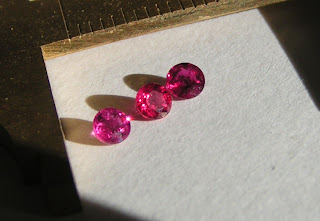Rubies for the Masses – Glass Filled!
You might have heard about glass filled ruby scams on the news, they were a big story last year. Or you read about them in my etsy listings. Anyway, when glass filled rubies first became big in 2004 and 2005, they also fooled a lot of dealers on 47th Street. Just the other day, an older man approached my gemstone dealer to sell a large faceted ruby. D. refused to buy. The old man wanted a $1000 at first, then lowered and lowered his price, until he had arrived at $50 or so. To humor the old man, D. louped the stone, but still refused to take it. The old man was offended, so D. took him to another dealer. The other dealer refused the stone as well. After some back and forth, D. finally explained to the old man that the ruby was glass filled and not worth much of anything. The old man’s face literally fell. He had probably been cheated, thinking he got a large stone for a good price and saving it for a rainy day, when he really needed the money. And stories of this kind abound on the street – they are infinitely more common than the converse – stories of someone stumbling across a small fortune by accident.
So, what is a glass filled ruby, and why is the process done? Let me quote from gemselect, one of my favorite online gem stores:
"Small cracks or fractures in a gemstone can interrupt the flow of light through the stone, creating white or "dead" spots in the color of the stone. Sometimes these fractures–if they reach the surface of the stone–will be filled with material that will allow the light to pass through smoothly. Different chemicals are used; oil, wax, glass, epoxy, and borax are common materials. These tiny filled cavities are difficult to see without the aid of optical instruments, so the buyer should be aware of this practice."
Glass filling, also called “fracture filling” (because other fillers can be used) improves both the color and the clarity of the gem. Rubies are rarer than diamonds, at least in the bigger sizes. Because of the large market demand, availability of good ruby material is dwindling. Glass filling allows lesser ruby materials to be improved sufficiently to be used in jewelry. (Here’s a picture of a glass filled ruby from gemselect, 1.22 ct for $34.83 – gemselect has untreated rubies, but only from Madagascar
The most highly prized rubies, still, are Burma Thailand or Madagascar cannot rival the Burma
 |
| Thai Rubies, Completely Untreated |
In terms of pricing, there is a huge difference between glass filled rubies and natural rubies, even compared to rubies that have undergone slight heat treatment (which can also make the stone duller, incidentally). According to Richard Wise’s Secrets of the Gem Trade, “eye flawless ruby, particularly untreated, is extraordinarily rare…. Because of the gem’s extreme rarity, the collector-connoisseur may find that otherwise beautiful stones with a few eye-visible inclusions are acceptable.” (P. 180)
 |
| 3mm Burma rubies, completely untreated and not yet set, nearly eye clean |
Regarding disclosure: heat treatment is not always disclosed, but you should assume that any ruby you buy is heat treated. Completely untreated rubies will be marketed as such, because a dealer can demand a further premium on those. Glass filling, or fracture filling, should be disclosed, even if the buyer doesn’t ask. But note that many jewelry chains employ untrained personnel, especially during the holiday season. So you must ask, and if the seller doesn’t know then ask for someone who does know. Don’t blame the sales person, a lot of this gemstone information is tricky. Each stone is different and you should not expect someone who is hired to help out during the busy season to know. If you are going to a reputable jeweler, however, and they don’t know, that’s not good.
 |
| Same gorgeous ruby suite, different angle |

